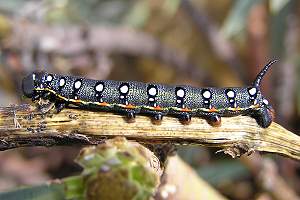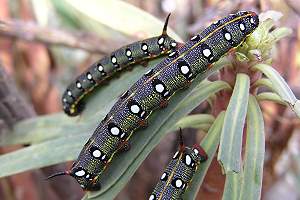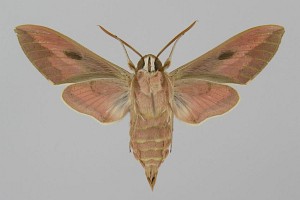

 +3Kontinente:EU
+3Kontinente:EU1. Falter
4. Biologie
4.1. Nahrung der Raupe
- Euphorbia dendroides
Nach Fritsch et al. (2014) wurden die Raupen auf Samos in der zweiten Maihälfte an Euphorbia dendroides gefunden.
5. Weitere Informationen
5.1. Taxonomie
Die [Fauna Europaea] verweist darauf, dass dieses Taxon möglicherweise ein Hybrid zwischen Hyles euphorbiae und einem Taxon des Hyles tithymali-Komplexes ist.
Konkreteres ist durch Mende & Hundsdoerfer (2014) zu erfahren. Sie vergleichen das Taxon sammuti mit dem Taxon cretica und stellen dabei unterschiede in der Eigenständigkeit fest; sie schreiben dazu in ihrer Einführung: "The validity of the Maltese H. “sammuti” has further been challenged based on mitochondrial markers, since it is mainly composed of a mixture of the euphorbiae and tithymali haplotype clusters (Hundsdoerfer et al., 2005a; 2009a; 2011b). In contrast, the validity of H. “cretica” is surprisingly corroborated by a distinct haplotype cluster, which is endemic to the southern Aegean Islands and currently the only cluster found there. Although this cluster is very close to the tithymali cluster and might thus be regarded as a sublineage of H. tithymali (see discussion for details), its distinctiveness suggests a long-term isolated evolution in a southern Aegean refuge during and since at least the last glaciation (Hundsdoerfer et al., 2011b)."
5.2. Verbreitung
Nach Fritsch et al. (2014) ist die Art auch auf der griechischen Insel Samos weit verbreitet und kann dort sowohl als Raupe als auch als Falter bis 800 m fast überall angetroffen werden. Mende & Hundsdoerfer (2014) fanden entsprechende Haplotypen auf Kreta, Rhodos, Samos und Chalki, nicht aber auf den weiter nördlich gelegenen Ägäis-Inseln.
5.3. Typenmaterial
Danner, Eitschberger & Surholt (1998: 251): „Holotypus ♂ (Spannweite: 6,9 cm; Taf. 25, Abb. 1^) Eltern ex Kreta 1987, e.o. 11.ix.1988, Surholt cult. et coll.
Allotypus ♀ (Spannweite: 7,3 cm; Taf. 25, Abb. 2); Kreta, 1987, e.o. 14.x.1988, Surholt cult. et coll.;
Paratypen, alle aus Kreta: 3 ♂♂, 2 ♀♀, e.o. 1987, Danner cult.; 1 ♂, 1 ♀, e.o. 14.x.1988, Surholt cult. im EMEM; 1 ♂, 1 ♀, NZ ix.1987: SMID, ii.1988, in coll. Harbich; weitere Paratypen in coll. F. Karrer, Zofingen (Schweiz).“
(Autor: Erwin Rennwald)
5.4. Literatur
- Erstbeschreibung: Danner, F., Eitschberger, U. & B. Surholt (1998): Die Schwärmer der westlichen Palaearktis. Bausteine zu einer Revision (Lepidoptera, Sphingidae). — Herbipoliana 4 (1): Textband: 1-368. Tafelband: 772 S., pl. 1-571.
- Fritsch, D., Stangelmaier, G., Top-Jensen, M., Bech, K. (2014): Die nachtaktive Großschmetterlingsfauna von Samos (Griechenland, Östliche Ägäis) (Lepidoptera: Cossoidea, Lasiocampoidea, Bombycoidea, Drepanoidea, Geometroidea, Noctuoidea). — Esperiana. Buchreihe zur Entomologie. Band 19: 7-101. Bad Staffelstein.
- Hundsdoerfer, A.K., Kitching, I.J. & M. Wink (2005): The phylogeny of the Hyles euphorbiae complex (Lepidoptera: Sphingidae): Molecular evidence from sequence data and ISSR-PCR fingerprints. — Organisms, Diversity & Evolution, 5: 173–198.
- Mende, M.B. & A.K. Hundsdoerfer (2014): More evidence for an admixture of the Hyles euphorbiae complex’s main lineages in Mediterranean Europe (Lepidoptera: Sphingidae). — European Journal for Entomology 111(4): 584–587. doi: 10.14411/eje.2014.065 [PDF auf eje.cz]












